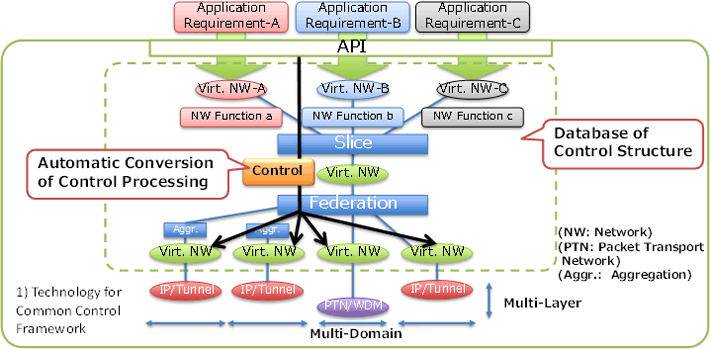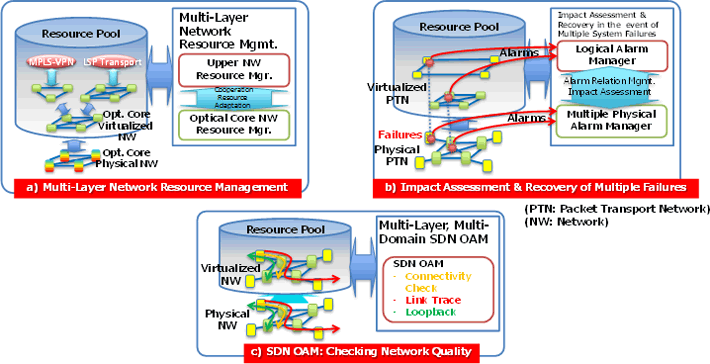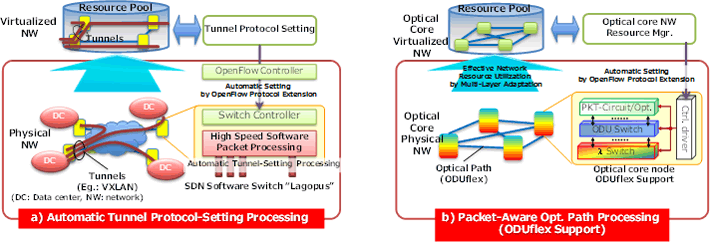Microsoft ends support for Internet Explorer on June 16, 2022.
We recommend using one of the browsers listed below.
- Microsoft Edge(Latest version)
- Mozilla Firefox(Latest version)
- Google Chrome(Latest version)
- Apple Safari(Latest version)
Please contact your browser provider for download and installation instructions.
March 10, 2016
NEC Corporation
Nippon Telegraph and Telephone Corporation
NTT Communications Corporation
Fujitsu Limited
Hitachi, Ltd.
SDN technologies developed and verified to provide a stable telecommunications environment within a wide area network: a global first
Tokyo, March 10, 2016 - NEC Corporation (NEC), Nippon Telegraph and Telephone Corporation (NTT), NTT Communications Corporation (NTT Com), Fujitsu Limited (Fujitsu) and Hitachi, Ltd. (Hitachi) today announced the development of Software-Defined Networking (SDN, *1) technologies that enable wide area network resources to be secured dynamically in response to individual applications' network quality requirements and use. The technologies, which are a global first, have also been verified within an actual wide area network environment.
These technologies were developed through the "Open Innovation Over Network Platforms" research and development project, the world's first research and development project aimed at enabling the total SDN compatibility of wide area networks. Also known as the "O3 (O Three) Project" (*2), this initiative was launched in June 2013 based on research consigned by the Ministry of Internal Affairs and Communications' Research and Development of Network Virtualization Technology, and has been promoted jointly by the five companies (*3).
By using these technologies, a variety of virtual wide area networks can be constructed on top of multi-layer (*4) and multi-domain (*5) networks connecting several telecommunications carriers and service platform operators (*6). These networks could be constructed on demand to meet the quality requirements of various applications. They could also handle changes in user activity (changes in applications, an increase in the number of users) through the flexible provision of resources, thereby preventing a drop in quality and providing a stable network environment.
Background
An increasingly diverse range of devices and applications are used through networks today, making it difficult for a single best-effort network to meet the different quality requirements, such as simultaneously available bandwidth capacity, control delay, security, and reliability. The situation calls for technologies that can dynamically allocate and utilize resources within wide area networks in response to the quality requirements and user activity of applications.
While some companies and data centers are realizing dynamic resource allocation through a virtual network involving logically multiplexed physical networks, no virtual networks have been realized in multi-layer/multi-domain wide area networks that connect telecommunications carriers and service platform operators.
The new technologies enable virtual wide area networks to be constructed on demand to fulfill the quality requirements of various applications, as well as prevent quality deterioration by enabling configuration changes to be made in response to user activity. This makes them the basis for various social infrastructure services that are essential for realizing the "smart society" of the future.
Technological Achievements of the Project
Details of the developed technologies are as follows. (Appendix 1)
1.Technology for a common control framework
This technology structuralizes complex network configurations that span multiple layers (wireless, optical, packet, and other networks) and multiple domains, enabling the integrated and rapid construction/operation of virtual wide area networks.
The technology takes virtual networks comprised of multi-layer/multi-domain networks and creates a database of their control structures. The database is used to visualize the virtual network, as well as automatically convert construction- and control-related processes to processes directed at devices comprising the physical network. These processes are then executed automatically.
As a result, it becomes possible within a virtual wide area network to introduce value-added functions for individual applications, such as enhanced security through real-time analysis of transferred data, improved throughput achieved by traffic distribution, and improved reliability through redundancy.
2.Technologies for integrated control of multiple layers and domains
These technologies use the virtual network's control structure database mentioned in 1. to construct a resource pool that stores the relationship between the layers and domains within the physical and virtual networks. This enables the dynamic allocation of network resources that exist across different layers and domains, and realizes the efficient use and stable operation of virtual wide area networks.
Specifically, they refer to technology for managing multi-layer network resources, technology for impact assessment and recovery in the event of multiple system failures, and technology for checking the quality of the entire virtual network, such as OAM (*7) functions within SDN.
Whereas network control previously required layer- and domain-specific operations, the new technologies will remove physical constraints such as location and configuration, and enable a holistic approach combining resources across the entire network. This will improve the efficiency, usability, and convenience of virtual wide area networks.
Even service platform operators, who do not own physical network resources, will be able to provide added value by creating unique functions through software control. These could include real-time communications transfer control that responds to communications content, traffic distribution through the flexible switching of networks, and network redundancy for bypassing faults in the event of system failure.
3.Technologies for developing virtualization-compatible SDN nodes
These technologies use the integrated control of multiple layers and domains to realize communications devices (nodes) that enable flexible changes in the network configuration and network quality of telecommunications carriers. They are aimed at telecommunications carrier networks comprised of networks within data centers (DCs) and networks between DCs, and consist of two technologies: "automatic tunnel-setting processing" and "packet-aware optical path processing."
The "automatic tunnel-setting processing" technology is aimed at networks within DCs and the connection between networks within and between DCs. It automatically sets a tunnel protocol for configuring a virtual network within the SDN software switch. This technology is an expanded version of the high-performance open-source SDN software switch Lagopus (*8), which the project has been developing.
The "packet-aware optical path processing" technology is aimed at networks between DCs. Based on the situation of resources within the upper packet transport layer, it provides multiple optical paths (ODUflex, *9) of optical core networks with various band frequencies within the lower layer. For the control, the project proposed and standardized the OpenFlow protocol expansion method (*10), which is similar to packet layer control.
Whereas each network previously required separate nodes, the new technologies enable a single node (multi-layer node) to realize the optical core network and packet transport, and another to realize the IP network and tunnel protocol. This reduces the number of nodes and enables the efficient use of resources, and can lead to lower capital expenditure (CAPEX).
In addition, by realizing automated tunnel protocol setting and the automated and targeted control of optical paths, operating expenditure (OPEX) can also be reduced.
 Overview of technological achievements
Overview of technological achievements
Furthermore, the above three outcomes have been verified using an actual wide area testing environment (*11) built for the experiment (a global first). Assuming a physical multi-layer/multi-domain wide area network with 1,000 nodes, and by constructing and controlling 100 virtual networks, the partners verified that a virtual wide area network can be controlled through a service application.
Main Division of Work for the Five Participating Companies
| NEC | : | Technology for a common control framework (Feature 1), technology for resource management within a multi-layer network (wireless domain) (Feature 2) |
| NTT | : | Technology for developing a high-performance SDN software switch, technology for automatic tunnel setting (Feature 3) |
| NTT Com | : | Technology for checking the quality of the entire virtual network (Feature 2) |
| Fujitsu | : | Technology for resource management within a multi-layer network (optical domain) (Feature 2), technology for packet-aware optical path processing (Feature 3) |
| Hitachi | : | Technology for impact assessment and recovery in the event of multiple system failures (Feature 2) |
Future Plans and Outlook
This project aims to commercialize the results of research and development on wide area SDN. It will also consider utilizing them as a basis for various services related to the Internet of Things (IoT), which is expected to develop further, and as key technologies for realizing the fifth-generation (5G) network.
The outcomes of this project will be presented at "O3 Symposium 2016," which will be held at Akihabara UDX on March 23, 2016. (Appendix 2)
*1:Software-Defined Networking (SDN) is a concept for controlling a network via software.
*2:O3 Project Website http://www.o3project.org/en/index.html
O3 stands for the overall concepts of this project: open, organic and optimum.
*3:See the press release "O3 Project launched for achieving the world's first wide area SDN."
http://www.nec.com/en/press/201309/global_20130917_01.html
*4:Multi-layer: A network structure comprised of a combination of multiple networks with different layers, such as wireless, optical, and packet networks.
*5:Multi-domain: A network structure comprised of a combination of multiple networks with different managing entities (domains).
*6:Service platform operators: Operators that borrow physical network resources from telecommunications carriers and provide telecommunications or added-value services using a virtual network. This may include operators grown out of Internet service providers (ISPs) and virtual network operators (VNOs).
*7:OAM: Operations, Administration, Maintenance; a system for operating and managing networks.
*8:Lagopus (SDN software switch) http://lagopus.github.io/
*9:ODUflex: A method of transmission using optical multiplexing that enables housing in the optical path at 1.25Gb/s units in response to the telecommunications bandwidth capacity requested by the user.
*10:OpenFlow protocol expansion method: A method that conducts integrated control of the packet layer, line layer, and wavelength layer based on the OpenFlow protocol.
*11:Test facilities installed at NTT Com's data center were verified by connecting to a wide area network test environment through JGN-X, a network test bed for research & development at the National Institute of Information and Communications Technology (NICT).
Trademarks
Company names and other proper names in this release are the trademarks or registered trademarks of their respective companies.
[Appendix 1] Reference (Details of individual technologies)
1.Technology for a common control framework

2.Technologies for integrated control of multiple layers and domains

3.Technologies for developing virtualization-compatible SDN nodes

[Appendix 2] Symposium outline
- -Date: March 23, 2016 (Wednesday)
- -Venue: Akiba Square (2F, Akiharaba UDX Building)
- -Host: O3 Project
- -Capacity: 300 guests
- -Registration: Please register using the online booking form
http://www.o3sympo.com/ (japanese) - -Schedule
11:00 Doors open 11:00-13:00 Exhibition 13:00-13:10 Opening remarks
Ministry of Internal Affairs and Communications (TBD)13:10-13:40 Guest lecture 1
"Toward a medical information communications experiment and SDN within a high-speed network"
Yuichi Fujino, Professor, Future University Hakodate13:40-14:10 Guest lecture 2
"The business potential of large-format UHD* screens"
Akira Yoshizawa, Executive Controller, Media Planning Bureau, Japan Broadcasting Corporation*UHD (Ultra High Definition) is a standard of ultra high-definition televisions, imaging systems, and broadcasts with a large number of pixels. The resolution is either 4K (known as 4K UHD) or 8K (known as 8K UHD).
14:10-14:40 Guest lecture 3
"Initiatives for realizing a smart IoT society and outlook for the future"
Hideyuki Tokuda, Professor, Keio University/Keio University Graduate School14:40-15:20 Research outcomes presentation
Results of "Research and Development of Network Virtualization Technologies" (Research consigned by the Ministry of Internal Affairs and Communications)
Yoshiaki Kiriha, Senior Principal Researcher, Cloud System Research Laboratories, NEC Corporation15:20-15:30 -Break- 15:30-16:45 Panel discussion
"Building a comfortable and bright future: SDN enters the next stage"
Moderator
Shuji Nakamura, Deputy General Manager, Policy and Public Affairs Business Unit, Mitsubishi Research Institute, Inc.
Panelists- - Yuichi Fujino, Professor, Future University Hakodate
- - Yosuke Yamashita, Kashiwa City Council member and Education consultant
- - Kosuke Ito, Secretary General, Connected Consumer Device Security Council
- - Tomoaki Sakurai, Service Design Study Group, Okinawa Open Laboratory
- - Akiko Yamada, Assistant to General Manager, First Business Division, SDN Solution Business Unit, Fujitsu Limited
- - Takashi Torii, Board Member, Japan OpenStack User Group/Manager, Okinawa Open Laboratory
-17:30 Exhibition and demonstration
Exhibition and demonstration of research outcomes
Contact;
NEC Corporation
Corporate Communications Division
Tel: +81-3-3798-6511
E-Mail: j-jasper@ax.jp.nec.com
Nippon Telegraph and Telephone Corporation
Science and Core Technology Laboratory Group,
Public Relations
Tel +81-46-240-5157
E-Mail: a-info@lab.ntt.co.jp
NTT Communications Corporation
Corporate Planning Division
Tel: +81 3 6700-4010
E-Mail: o3-nttcom@ntt.com
Fujitsu Limited
Public and Investor Relations Division
https://www.fujitsu.com/global/about/resources/news/presscontacts/form/index.html
Hitachi, Ltd.
Information & Telecommunication Systems Company Public Relations Department
E-Mail: koho@itg.hitachi.co.jp
Information is current as of the date of issue of the individual press release.
Please be advised that information may be outdated after that point.
NTT STORY
WEB media that thinks about the future with NTT











